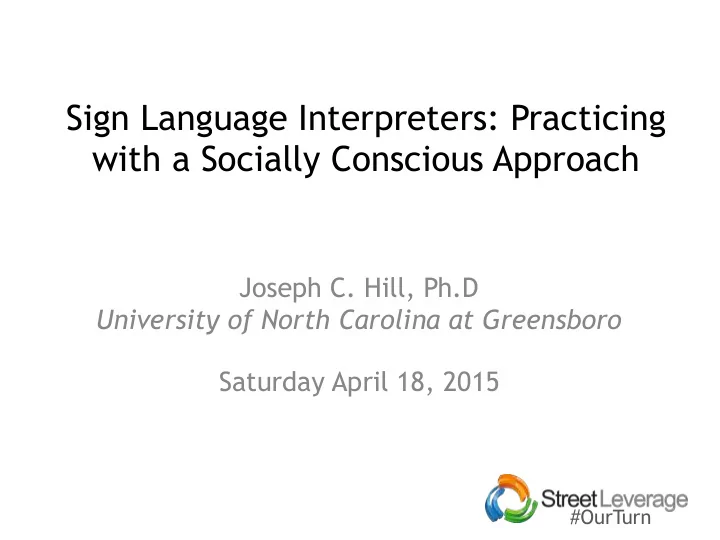

Sign Language Interpreters: Practicing with a Socially Conscious Approach Joseph C. Hill, Ph.D University of North Carolina at Greensboro Saturday April 18, 2015 #OurTurn
The History Structure of Black ASL • Chronicle the history of the education of Black Deaf children during the segregation era. • Create a filmed corpus of conversational (vernacular) Black ASL as it is used in the South . • Provide a description of the linguistic features that make Black ASL recognizable as a distinct variety of ASL (e.g. greater use of 2-handed signs, larger signing space. • Disseminate the findings in the form of teaching materials and instruction resources . #OurTurn
RID Membership Demographics Gender Number of Members (those who reported) Female 8,958 Male 1,294 Ethnic Origin Number of Members Percentage (Reported to the survey) Euro-American/White 8,197 87.71% African American/Black 443 4.7% Hispanic/Latino(a) 374 4% Asian American/Pacific 171 1.82% Islander American Indian/Alaskan 81 0.86% Native Other 79 0.84% Total: 9,354 (out of 16,004 members) #OurTurn Source: RID Views, Winter 2014
Black Deaf Consumer’s Perspective about Interpreters Video from NCIEC Social Justice Education Infusion Module developed by Drs. Dave Coyne and Joseph Hill #OurTurn
Social Consciousness • A critical awareness of people’s roles (including ours ) in the reality of social, economic, political, and structural disparities. EXPANDED DOMINANT MARGINALIZED AWAKENED CULTURES CULTURES ACQUIRED Image modified from Lynne S. Giddings, 2005. “A theoretical model of #OurTurn social consciousness.” Advances in Nursing Science , 28(3), pp. 224-239.
Comfortable being uncomfortable Excerpts from Mellody Hobson (March 2014), “Color blind or color brave?”, TED talks • “In my view, color blindness is very dangerous because it means we’re ignoring the problem.” • “So I think it's time for us to be comfortable with the uncomfortable conversation about race: black, white, Asian, Hispanic, male, female, all of us, if we truly believe in equal rights and equal opportunity in America, I think we have to have real conversations about this issue. ” #OurTurn
Be Open, Lean In, Dig Deep. • In order to change, we have to… – be willing to be vulnerable. – examine our relationships with stakeholders, professionals, and consumers. – recognize our roles in perpetuating the disparities. – witness the multiple realities and stories among us. – engage in a dialogue and accept it as an effective form of action. • Real conversations can create changes. #OurTurn
We Are Change. #OurTurn
Recommend
More recommend